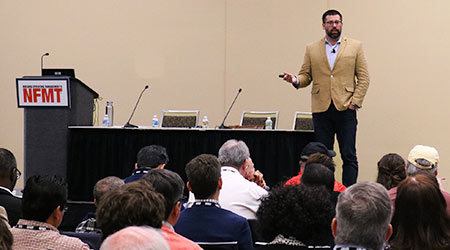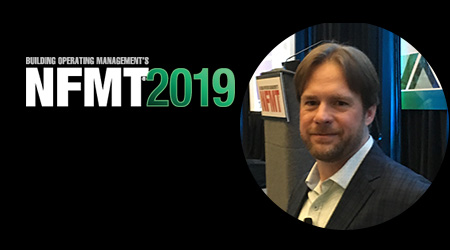
Finding Energy Efficiency Opportunities in Existing Buildings
April 23, 2019
Existing commercial and institutional buildings offer facility managers a wealth of proven ways to increase energy efficiency. Two speakers at this year’s National Facility Management & Technology (NFMT) conference and exposition described some of the best opportunities to improve operations and upgrade building technologies.
In a session entitled “Building Retrofits for Efficiency and Cost Savings,” Jesse Fisher, senior engineer, WB Engineers+Consultants, described an array of lighting and HVAC upgrades worth considering, even in buildings constructed in the past 10 to 20 years. One good example is replacing T8 lamps in little used areas where lights are always on, like stairwells and parking garages with LEDs. Such upgrades may pay for themselves in only a year, Fisher said. Adding occupancy sensors can cut energy use in half even after the switch to LEDs.
A good opportunity to cut energy use is when systems are at the end of their useful lives. Instead of replacing in kind, consider more efficient replacement options. For example, a condensing gas water heater offers energy savings at a relatively small extra cost, while selecting an electric water heater that uses a heat pump can bring a payback of two to three years.
More gains are available from putting in a more efficient recirculating pump and upgrading controls.
Rooftop units are another technology that has seen energy efficiency gains. “They’ve come a long way in the past 15 years,” Fisher said. Features to consider include economizers, single-zone VAV capability, supply air temperature reset, and duct static pressure optimization; they can bring significant energy savings at relatively modest extra cost.
HVAC upgrades require careful analysis. For example, a water heater that uses a heat pump will cut overall energy use more in warm climates than in cold ones. And VFDs need to be applied properly to deliver anticipated savings. They must be used with inverter rated motors, for example, and control adjustments may be required.
The first step in improving energy efficiency in an existing building, said Al Skodowski, principal of Rivion and a member of the Building Operating Management Editorial Advisory Board, is to “know your numbers” — a building’s energy profile, energy costs, utility rates, and number of occupants. That information will be essential to evaluating measures to improve energy performance.
Many actions to improve operations can be taken immediately, Skodowski told NFMT attendees. His to-do list included tuning up outside air and exhaust air systems, cleaning coils, changing filters, and implementing preventive maintenance on equipment. Skodowski also suggested that NFMT attendees consider having the energy meter read every day for a month and recording daytime and nighttime energy use. If the latter is more than 65 percent of the former, it’s a sign that something is on at night that shouldn’t be on — an easy opportunity for savings.
These basic measures are important even for buildings that are aiming for zero net energy status. “There’s no way you’re going to et to zero if you can’t tackle this simple stuff,” he said.
Another idea is to stop Saturday and Sunday HVAC run hours. “See who complains and deal with that group separately,” Skodowsi said. That approach requires you to know your building’s occupants, of course.
Ed Sullivan is editor-in-chief of Building Operating Management.
Next
Read next on FacilitiesNet












